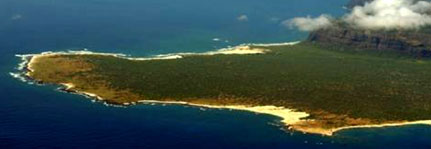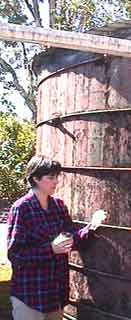|
Local
Hero: Hawaii's Guru of Water Catchment- Trisha Macomber
by Doug Pushard

Who
You Going To Call?
You
have questions on your rainwater catchment system and need some
answers quick. Questions like, "How do I know it's safe to
drink the water? How do I test my water? What do I test for? Is
it okay to swim in my catchment basin?"
 If
you live in Hawaii, you are lucky. You have Trisha Macomber
to turn to. She retired from the University
of Hawaii in the department of Natural Resources and
Environmental Management as an Educational Specialist. But
she put in many programs still in use and was the Click
and Clack of rain catchment systems in Hawaii. She has been
the liaison to the public since 2000 specializing in rainwater
systems and spends her time answering questions like those above
(i.e. Yes, these are real questions and the names have been removed
to protect the guilty), giving seminars, updating the website,
hand delivering information and providing guidance to local builders
and new residents on designing new systems. If
you live in Hawaii, you are lucky. You have Trisha Macomber
to turn to. She retired from the University
of Hawaii in the department of Natural Resources and
Environmental Management as an Educational Specialist. But
she put in many programs still in use and was the Click
and Clack of rain catchment systems in Hawaii. She has been
the liaison to the public since 2000 specializing in rainwater
systems and spends her time answering questions like those above
(i.e. Yes, these are real questions and the names have been removed
to protect the guilty), giving seminars, updating the website,
hand delivering information and providing guidance to local builders
and new residents on designing new systems.
Why
does Hawaii need a full-time rainwater person you might wonder;
especially since most of Hawaii averages over 100 inches (254
centimeters) of rain a year? At Hilo International Airport, which
averages about 126 inches (320 centimeters) of rainfall annually,
only 2.65 inches (6.7 centimeters) fell in May of 2005. And just
over 2 inches (5 centimeters) fell during the same period in Pahoa
in Lower Puna. Hawaii is blessed with lots of annual rain, but
also has spells of drought. Additionally, in some rural areas
there is no municipal water at all and drilling a well through
hard, volcanic rock would be prohibitively expensive, so hauling
water in or rainwater collection are the only sources of water.
Information
tallied in late 2004 by the Fire Department shows that approximately
17,900 Big Island households are not served by a municipal water
system. With an average of 2.8 people per household, that means
more than 50,000 residents -- nearly a third of the Big Island's
current population -- have a big stake on the whims of the weather.
Ironically,
central Puna, with more than 8,000 homes on catchment, averages
better than eight feet (2.44 meters) of rain per year, enough
to keep storage tanks full most of the time. But without water
conservation, such as limiting laundry and minimizing other uses,
even a few weeks without rain can leave residents with empty or
low tanks. The Puna and Ka'u areas have the largest percentage
of residents on catchment estimated at 75 percent and 43 percent,
respectively.
So
rainwater catchment is critical to a lot of people in Hawaii.
In fact, it is a way of life! Trisha Macomber got interested professionally
in rainwater systems in 1999, when a colleague asked her about
leptospirosis. It was a serious heath problem at the time
but there was no public information for those using rainwater
as their water supply.
So
Trisha, a biologist with a masters in public health, authored
the
Guidelines on Rainwater Catchment Systems for Hawaii (PDF).
This excellent guide covers not just the health issues of systems
but also how to build a system as well as how to store rainwater
to keep it clean and healthy. Since its publication in 2002, over
13,000 hardcopies have been distributed and thousands more have
been downloaded from the web. She has been called the Big Island’s
“guru” of water catchment.
Besides
Trisha’s passion for rainwater systems, she and her husband
enjoy reading, playing with their cats and dogs and volunteering.
They have been on the island of Hawaii for 26 years and Trisha
brought her first house with a rainwater catchment system in 1981.
Her Hawaiian husband, Ed, grew up using catchment systems.
Free
Rainwater Harvesting Advice for Beginners
Trisha
is amazed at the current growth spurt in Hawaii and the resulting
number of new catchment installations. She offers potential new
users the following advice.
- Read
the guidelines
- Ask
lots of questions
- Think
about preventive control and health issues before starting
- Buy
a tank with a solid cover
And for those lucky enough to be on the Big Island, email
or call her if you have any questions. She remains excited
about the all the new developments she is seeing in harvesting
rainwater systems but would like to see more information and products
in the area of complete home point of entry UV systems, integrated
whole house water catchment systems, and on first flush devices.
Trisha
Macomber, a local hero, to those in Hawaii and beyond.
Mahalo iâ `oe
(mah hah' loh (y)ee (Y)AH' oe) for all your efforts to get
more folks interested and aware of how to catch and harvest rainwater
effectively and safely.
Related
Site:
Free
site with articles on Agriculture and other topics including
the Rainwater Guidelines for Hawaii - Guidelines on Rainwater
Catchment Systems for Hawaii.
|